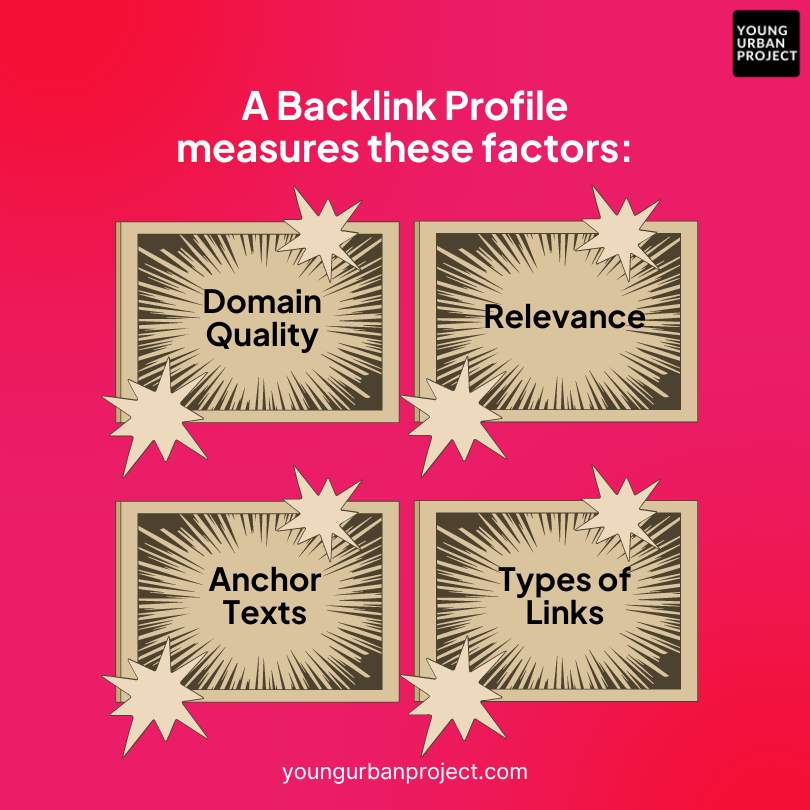A backlink profile is an important part of SEO. These links bring visitors to your site and help search engines like Google decide how to rank your site. Knowing how your backlink profile works can improve your SEO strategy, increase your organic traffic, and boost your search engine rankings.
For the best results, focus on getting high-quality backlinks from relevant websites. These backlinks help raise your position in search results and drive more traffic to your site. These links must look natural.
Building a strong backlink profile takes time, effort, and often some investment.
Table of Contents
What is a Backlink ?
A backlink is a link from one website to another. It helps improve your site’s search engine ranking and can bring direct traffic. Backlinks from reputable sites boost your site’s authority and trust.
Types of Backlinks
1. Dofollow Backlinks: These are the most common type of backlinks. They pass SEO value/authority (often called “link juice”) from the referring site to your site, helping to improve your search engine rankings. When another site links to yours with a dofollow link, it signals to search engines that your content is valuable and worth ranking higher.
2. Nofollow Backlinks: Unlike dofollow links, nofollow backlinks do not pass SEO value. They are used to tell search engines not to follow the link, which means they don’t directly affect search rankings. Nofollow links are often used in blog comments, social media, or paid advertisements. While they don’t boost SEO directly, they can still bring traffic to your site.
3. Sponsored Backlinks: These are links given in exchange for payment. They are labeled with a rel=”sponsored” attribute to show that they are part of a sponsorship deal. While useful for driving traffic, they don’t usually impact search rankings due to their paid nature.
4. UGC (User-Generated Content) Backlinks: These links come from user-generated content, such as forum posts or reviews. They are marked with a rel=”ugc” attribute to indicate they are created by users. UGC backlinks can be valuable but should be monitored to ensure they come from reputable sources.
5. Editorial Backlinks: These are high-quality links given naturally by other sites when they mention your content. If your content is valuable and relevant, other websites may link to it within their articles, blogs, or resources. Editorial backlinks are highly prized for SEO.
6. Resource Page Backlinks: These links come from pages that list useful resources or tools in a specific field. Being listed on such pages can drive traffic and boost your site’s credibility within its niche.
7. Guest Post Backlinks: When you write and publish an article on another website (a guest post), you often get a backlink to your site. These links can be very effective if the guest post is on a reputable site related to your field.
8. Contextual Backlinks: These are links placed within the main content of a page rather than in sidebars or footers. Contextual backlinks are more valuable because they are part of the article or content that is relevant to the topic being discussed.

What is a Backlink Profile?
A backlink profile is the complete set of backlinks pointing to your website from other sites. It includes information about the types of links, their anchor text (the clickable words), the quality of the referring domains, and how relevant they are to your site.
To improve your SEO and backlink strategy, it’s important to regularly analyze and maintain your backlink profile to ensure it’s well-organized and supports higher search engine rankings.
A backlink profile measures several key factors, including:

- Domain Quality
- Relevance
- Anchor Text
- Types of Links
Where Can you Find your Website’s Backlink Profile?
To find and assess your backlink profile, SEMrush Backlink Analytics is a great tool. SEMrush offers comprehensive tools to analyze your backlinks, helping you understand who is linking to your site, the quality of those links, and their impact on your SEO performance.
Here’s how you can use SEMrush to check your backlink profile:
- Sign Up or Log In: Access SEMrush by creating an account or logging into your existing one.
- Navigate to Backlink Analytics: Go to the Backlink Analytics section within the SEMrush dashboard.
- Enter Your Domain: Input your website’s URL into the search bar to generate a detailed backlink report.
- Analyze Your Backlinks: Review the report to see metrics such as the number of backlinks, referring domains, link quality, and anchor text distribution.
Using SEMrush, you can gain valuable insights into your backlink profile, identify strengths and weaknesses, and take steps to enhance your link-building strategy.
Also Read: How to do an SEO Audit for any website
What Is a Backlink Analysis?
A backlink analysis evaluates the quantity and quality of backlinks pointing to your site and your competitors’ sites. It involves using tools to understand:
- Link Sources: Who is linking to the website.
- Domain Quality: The credibility of the linking domains.
- Anchor Text: The clickable text used in the backlinks.
- Link Types: The different kinds of backlinks and their potential impact on ranking.
Step 1: Go to SEMRush’s Backlink Analytics tool

Step 2: Enter the domain name of the website you want to analyze

Step 3: Go to the Backlinks tab to see the Backlink Profile

How to Build a Strong Backlink Profile
A strong backlink profile is key to improving your website’s SEO and authority. Backlinks act as endorsements from other sites, signaling to search engines that your content is credible and valuable. To build a robust profile, focus on acquiring high-quality, relevant links through strategic outreach, guest posting, and creating shareable content. In this guide, we’ll explore simple and effective ways to strengthen your backlink profile and boost your search engine rankings.
1. Focus on Quality Content
Create content that captivates, informs, and engages. High-quality, valuable content naturally attracts backlinks from reputable websites, boosting your site’s credibility and rankings.
2. Guest Blogging
Contribute insightful articles to high-authority sites within your niche. Ensure your guest posts are relevant to both your niche and the host site’s audience for maximum impact and valuable backlinks.
3. Create Shareable Infographics
Design visually appealing and informative infographics. Promote them on social media and connect with industry sites to encourage sharing, generating high-quality backlinks. You can use an AI tool like Piktochart to generate infographics for free.
4. Press Releases
Distribute press releases about significant updates or events related to your business. Publishing them on reputable news sites and industry platforms can generate valuable backlinks and increase traffic.
5. Niche Edits (Link Insertions)
Request to insert your links into relevant existing content on high-authority sites. This method, known as niche edits, leverages established pages to add value and acquire backlinks.
6. Digital PR Links
Engage in digital PR campaigns to build relationships with journalists and influencers. Secure mentions and backlinks from media outlets and industry leaders to enhance your site’s credibility and reach.
7. Forum and Social Profiles
Participate in industry-related forums and create profiles on social media platforms. Contributing valuable insights and including links to your site in your profiles or posts can drive traffic and build backlinks.
8. Pillow Links
Use pillow links to create a natural link profile. These are low-impact links from blog comments, social media profiles, or low-tier directories that help diversify your backlink profile.
Advanced Backlink Building Techniques
Once you start scaling beyond guest posts, profile-creation, and other beginner-level backlink techniques, you will need some advanced strategies.
Skyscraper Link Building
Originally proposed by Brian Dean from Backlinkio, this has been a popular technique to build backlinks. Here, you identify top-ranking pages for your target keywords, create superior content, and request backlinks from sites linking to the original content.
Broken Link Building
Find and report broken links on relevant sites. Offer your content as a replacement to help fix the issue while earning valuable backlinks.
Connect with Your Community
Leverage relationships with industry partners, vendors, and satisfied customers. Develop case studies and collaborate on content that earns backlinks through mutual sharing.
Local Link Building
For local businesses, complete your Google Business Profile and acquire local citations from directories and listings to enhance local SEO.
Optimize Anchor Text Naturally
Use anchor text strategically without overstuffing. Link to your content in a natural, contextually relevant manner to maintain a healthy SEO profile.
Focus on backlink quality more than quantity
In today’s SEO landscape (which, honestly, is quite different from what it was even a couple of years back), focusing on the quality of backlinks is far more crucial than amassing a large number. Search engines have evolved beyond valuing sheer quantity; they now emphasize the strength and relevance of each backlink. Here’s what makes a backlink valuable:
- Authority: Backlinks from high-authority websites carry significant weight. These are sites with a strong Domain Rating (DR), established credibility, and high-quality content. A link from such a site can greatly enhance your site’s credibility and search ranking.
- Relevance: Backlinks are most valuable when they come from sites related to your own content. When a website that covers similar topics links to yours, it helps search engines understand the context and relevance of the link, boosting your SEO.
- Do-Follow vs. No-Follow: Do-follow links contribute to your SEO ranking, as they pass along link equity. On the other hand, no-follow links don’t impact search rankings but can still drive traffic and create brand visibility.
By focusing on obtaining high-quality, relevant backlinks from authoritative sites, you can build a more effective and credible backlink profile.
Conclusion
Building a strong backlink profile is crucial for improving your website’s SEO and online visibility. Focus on getting high-quality, relevant backlinks rather than just accumulating many links. Start by creating valuable content that naturally attracts links. Consider guest blogging, making shareable infographics, and other strategies to earn more backlinks.
Use advanced techniques like skyscraper link building and broken link building to boost your profile. Engage with industry communities and leverage your existing relationships to gain authoritative links. Regularly check your backlink profile with tools like SEMrush and Google Search Console to keep it healthy and effective.
By prioritizing quality over quantity and continuously refining your approach, you can enhance your site’s credibility, drive more traffic, and achieve higher search engine rankings
FAQs about Backlink Profile
What is a link profile, and why is it important for SEO?
A link profile is the collection of all backlinks pointing to your website, including their quantity, quality, relevance, anchor text, and the diversity of their sources. It’s crucial for SEO because it influences how search engines assess and rank your site. A strong link profile helps boost your site’s credibility and search engine visibility.
How can I build a diverse backlink profile?
To build a diverse backlink profile, focus on obtaining various types of links from multiple sources, such as reputable websites, industry directories, social media platforms, and forums. Creating valuable content that naturally attracts backlinks and participating in relevant online communities can also help diversify your link profile.
What are the signs of an unhealthy link profile?
An unhealthy link profile may include too many low-quality or spammy backlinks, links from unrelated or irrelevant sites, sudden spikes in link acquisition (which could indicate black-hat SEO tactics), and an excessive use of exact-match anchor text. These issues can harm your site’s SEO performance and should be addressed promptly.
How often should I review my link profile?
Regularly reviewing your link profile is important to spot any issues and improve your strategy. Depending on your website’s size and complexity, you might conduct these reviews monthly, quarterly, or annually. Regular check-ups help you track changes and adjust your link-building efforts as needed.

